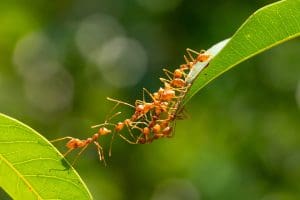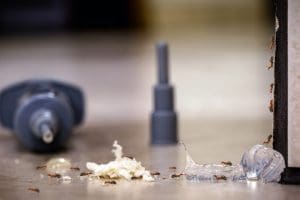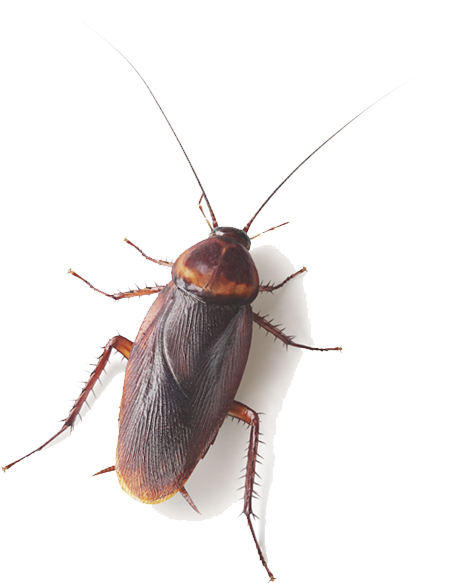How To Get Rid Of Ants
Have you ever been unlucky enough to experience an ant infestation before? It seems as though no matter how well you clean up, there always seems to be something in your home that feeds the seemingly never-ending hordes of ants year-round. Just when you may think you’re on top of your ant problem, a single stray crumb from a muffin can attract a whole new cohort of them just like that.
This isn’t entirely surprising, as there are around 500,000 ants in any given ant colony. That’s up to 500,000 insidious little bugs hiding in the nooks and crannies of your home. And not to alarm you too much, but that’s 3,000,000 ant feet marching in a scary sugar militia.
With numbers like these, sometimes you need expert know-how to help eliminate your ant problem. The sheer number of ants in a colony, combined with their tiny bodies, makes an ant infestation very hard to deal with on your own. That’s why we’re here to help.
Today, we’ll be sharing some of our top tips for dealing with ant infestations in your home, so read on to learn a little bit more about how you can curb the population of these creepy crawlies in your home spaces.
Today we’ll be answering the following questions:
- Why is it difficult to get rid of ants?
- How to get rid of ants?
- Why do I have ants?
- Common types of ants
- When are ants most active?
Why Is It Difficult To Get Rid Of Ants?
Before we dive into our top tips for getting rid of ants, let’s first explore what makes these particular infestations so tricky to deal with. Understanding why ants can be so difficult to eradicate can help you find the best ant control methods to suit your household.
For starters, ants live in colonies like bees, and these colonies possess complex social structures. This means that if you don’t kill all the ants in a nest, especially the queen, they will keep reproducing and raiding your kitchen floor for scraps.
Some invasive ant species such as Argentine and Big-headed ants will even have multi-queen structures within the same colony to give themselves a greater chance of survival, so you may have more than one ant regicide on your hands before the task is complete.
While many anti-ant products such as sprays and repellents claim to be able to rid your home of ants, they’ll likely only kill a few at best. So if you’ve tried a few treatments with no lasting success and have identified that you have a recurring ant problem, then you’ll want to enlist the help of pest control professionals.
How To Get Rid Of Ants
Now, let’s outline some of our top methods for getting rid of ants in the home.
Our top 8 methods to get rid of ants are:
1. Use a water and vinegar solution
2. Use natural ant irritants and pheromone maskers
3. Sprinkle diatomaceous earth powder anywhere you see ants
4. Use cornstarch to smother ants
5. Pour boiling water down anthills
6. Remove ant food sources around your home
7. Check houseplants for signs of ant nests
8. Block up any potential entrances for ants
1. Use a water and vinegar solution to keep ants at bay
If members of your household have allergies or are living with asthma and you’d prefer to use a gentler solution for combatting your ant infestation, then a simple solution of water and vinegar should be sure to do the trick.
All you need to do is mix your vinegar solution into a spray bottle and then spray areas around your home where you’ve observed ants passing or congregating. Even just one part vinegar to three parts water should do the trick here, as vinegar is a natural deterrent for ants. But if you wanted your solution to have more potency, that certainly wouldn’t hurt either.
2. Use natural ant irritants and pheromone maskers
There are other types of natural ant irritants out there that will do the trick alongside vinegar. This includes essential oils like peppermint, tea tree, and neem, as well as ground black or red pepper. All of these naturally occurring substances are ant deterrents and irritants as well as being fantastic methods for masking ant pheromones.
This is important because ants communicate navigational information to one another by leaving trails of their pheromones. That’s why ants are always spotted ‘marching’ in single file lines – they’re just following each other’s pheromones. When you dilute the strength of these pheromone signals, however, ants will begin getting ‘lost’ in your home, and those informational pathways become scattered, turning your home space into uncharted (and thus dangerous) territory. Divide and conquer!
3. Sprinkle diatomaceous earth powder anywhere you see ants
Contrary to popular belief, diatomaceous earth (or silica) isn’t toxic. It’s more of a natural dehydrator, which is why you find those silica bead packets in packaging for items like leather shoes, bags, or other goods that could accrue moisture damage. When you apply diatomaceous earth powder to insects, the substance naturally strips the oils from their bodies, causing them to dry up and die.
Sprinkling diatomaceous earth powder around entry points in your home can stop ants dead in their tracks quite literally. Just beware of using this particular method of ant control if you have pets or younger children. You don’t want anybody ingesting silica powder on your watch.
4. Use cornstarch to smother ants
As a thickener, cornstarch is great for smothering insects in the home, ants included. All you have to do is sprinkle some cornstarch over the ants, add water, and then let the mixture drown the ants whilst it also starts to thicken.
Once the mixture has fully thickened, simply remove the cornstarch and all the ants that have been encased within it! This is a great, low-mess and low-maintenance approach to clearing ants in your kitchen and bathroom spaces.
5. Pour boiling water down anthills
If you’ve managed to find some ant nests or anthills in your backyard, you’re likely to be wondering just how you can remove these populations without causing damage to your soil or wider garden spaces. Thankfully, eradicating anthills can be as easy as pouring boiling water right down into the mound to wipe out colonies at their source.
Not only will these kill hundreds if not thousands of ants in one fell swoop, but they’ll do so without contaminating your garden soil either, making this a great ant control method for green thumbs.
6. Remove ant food sources around your home
If any open food sources in your home have been known to attract ants (i.e. pet food bowls, bread boxes, etc.), then removing these sources can also help your household curb its rising ant population. We recommend placing all food items into your pantry spaces. You’ll also want to ensure that items with high levels of glucose or fructose (like honey, sugar, and ripe fruits) are kept on higher surfaces and firmly away from insects.
Remember that even bags of pet food are at risk of being contaminated by ants, as are breakfast cereals. For this reason, investing in lidded tubs and airtight containers for these food items can also prove valuable in your fight against ants.
7. Check houseplants for signs of ant nests
Keep in mind too, however, that food sources for ants can also include houseplants or even herb planters on window sills, so be sure to inspect these for signs of ant activities. If you have been able to detect larger ant populations or even ant swarms in the soil or on the leaves of larger houseplants, then you may opt to move these plants outdoors to ensure that fewer ants find their way into your home spaces.
8. Block up any potential entrances for ants
Finally, if you’ve been able to detect any ants entering your home through cracks or crevices around your doors, windows, or walls, then it’s highly imperative that you block up these potential entry points and thus, reduce the number of ants gaining access into your home. This can easily be done by following ant trails to their source and then using sealants to plug up these entry points promptly.
Once again, if any of these home methods for getting rid of ants don’t provide lasting results, then it’s highly likely that your home or garden contains larger colonies of ants (i.e. anthills) and your infestation can’t be eradicated until these colonies are removed. In this instance, it’s best to call professional exterminators who specialise in providing ant removal and control services. This is your strongest chance of reducing your ant population before it has the chance to climb into the millions from the hundreds of thousands.
Why do I have ants?
Well, for one thing, ants are everywhere in Australia! They might feed on the cupcakes at an inner-city picnic, burrow in the sands of the outback desert, or eat honeydew that soft scales, mealybugs, and aphids produce in a garden.
Ants may be attracted to a food source in your home such as sugar, syrup, honey, fruit juice, fats, and meat. Once they figure out where these food sources are, colonies can form long trails of thousands of ants to link nests to these food sources.
Do I have ants or termites?
Many people are unsure if they have a termite or ant infestation on their hands. It’s an important distinction to make as termites can damage the sound timber foundations of your home while ants only nest in wood that is already rotten. Ants have a segmented, hourglass waist shape while termites do not. You can also tell by the shape of their antennae; ant antennae are bent while termite antennae are straight.
Common types of Australian ants
Some of the species that often cause problems in Aussie homes are:
- White-footed black house ant,
- Big-headed ants (also known as major soldier ants),
- Pavement ant,
- Green-headed ant,
- Coastal brown ant,
- Minute house ant,
- Pharaoh ant,
- Sugar or carpenter ant,
- Argentine ant, and
- Pasture funnel ant.
As you can see, there’s a wide variety of ants that exist in our country! The type of ant that’s in your home will affect where they nest, and the strategies that will be most effective for getting rid of them. If you aren’t sure what kind of ants you have, it may be best to call in the experts to figure it out.
For example, several species can make use of the space in your house to form a nest frequently using areas such as your wall cavities, or even within electrical appliances. Other species may choose to nest within timber or create volcanoes of soil that smother your gardens and lawns. An expert ant exterminator will be able to trace the ants to the core of the colony thanks to their knowledge of how certain ant types tend to nest.
When are ants most active?
Ants are usually relatively dormant in winter and in colder conditions, and tend to become more active during the warmer months of October to March. In cooler parts of Australia, such as Melbourne, it’s also common for ant infestations to occur in the wintry months as ants may choose to concentrate their nests indoors.
If you suspect that you have an ant infestation on your hands in your Melbourne home, then be sure to consult the team at Pestline to do a little investigating and offer their expert support on addressing your ant infestation once and for all.
The Final Word
However stringent you may be with your prevention methods, if you have an established ant colony on your hands, you’ll most probably need to call in pest control. And whatever method you choose for eradicating your ants, we urge you to be wary of solutions that claim to be one-size-fits-all. A spray or bait that claims to destroy all your ants in a single spritz? It sounds too good to be true because it is. No one ant infestation is alike. It depends on a combination of factors such as the type of ant, your home, its inhabitants, and your habits. There are a lot of complex structures at play that make DIY ant exterminations quite tricky, not to mention dangerous if you’re using strong chemicals.
Only pest control experts have the experience and analytical minds to find the root cause of your ant infestation and stop these opportunistic little workers in their tracks. So give us a call at Pestline today and let us help you.
If you like this article, our pest experts recommend other blogs on getting rid of your common household pests:




